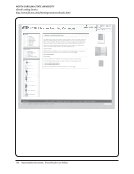68 · Survey Results: Survey Questions And Responses
Challenge 1 Challenge 2 Challenge 3
E-book reading interfaces/clients/ etc are
problematic
Licensing for services such as Kindle The old guard still things we should
have books in print, but that number is
declining.
Fiscal constraints. Multiplicity of platforms and interfaces. Scarcity of acceptable portable readers.
Funding for multiple formats for
identical content
Split user group -some with strong
preference for print, some appreciating
the advantages of electronic
Selection workflow disruptions for both
individual titles and collections
Getting catalog records User education
Getting MARC records routinely and
keeping track of what is available. Poor
quality of many MARC records supplied
by the publishers
Some faculty/student complaints
when the print is available before
the e-version. In some cases it is not
available, in other cases it is but it
appears that we don’t have access since
we haven’t yet loaded the MARC record.
Getting publishers to follow the same
licensing model as journals -(printing
and downloading restrictions stricter
with e-books)
Title availability Making users aware of these resources
Getting vendors to allow consortial
sharing and ILL
Promotion of use Obsolescence of titles
Inconsistency in usability Print vs e-version publishing time lag
— sometimes the e version is available
long after the print has been bought
ILL
Keeping track of it all! Did we get MARC
records? Did we get them loaded? Do
they work? If we didn’t get records,
have we cataloged the items and do
the links work? We are now working
to generate a list of ISBNs to load into
our book vendor’s database so that we
have a record of everything we bought
in their database. This will keep us from
having to search our catalog before
we order something from our vendor’s
database.
Platforms. The proliferation of platforms
is problematic for patrons and librarians
alike.
Funding. We were willing to pay extra
for e-books when they were rare
and wonderful because we wanted
to support a fledgling effort and get
it underway. Now that e-books are
established, it is time to see their cost
match that of print.
Lack of access from single platform (too
little cross-searching)
Pricing too high with respect to list price
(for multiple users)
Too few “frontlist” titles for scholarly
books
Lack of access standards varies widely
by platform.
Some business models preclude multiple
users.
Technical difficulties--getting locked out
of a book when reading too many pages
Challenge 1 Challenge 2 Challenge 3
E-book reading interfaces/clients/ etc are
problematic
Licensing for services such as Kindle The old guard still things we should
have books in print, but that number is
declining.
Fiscal constraints. Multiplicity of platforms and interfaces. Scarcity of acceptable portable readers.
Funding for multiple formats for
identical content
Split user group -some with strong
preference for print, some appreciating
the advantages of electronic
Selection workflow disruptions for both
individual titles and collections
Getting catalog records User education
Getting MARC records routinely and
keeping track of what is available. Poor
quality of many MARC records supplied
by the publishers
Some faculty/student complaints
when the print is available before
the e-version. In some cases it is not
available, in other cases it is but it
appears that we don’t have access since
we haven’t yet loaded the MARC record.
Getting publishers to follow the same
licensing model as journals -(printing
and downloading restrictions stricter
with e-books)
Title availability Making users aware of these resources
Getting vendors to allow consortial
sharing and ILL
Promotion of use Obsolescence of titles
Inconsistency in usability Print vs e-version publishing time lag
— sometimes the e version is available
long after the print has been bought
ILL
Keeping track of it all! Did we get MARC
records? Did we get them loaded? Do
they work? If we didn’t get records,
have we cataloged the items and do
the links work? We are now working
to generate a list of ISBNs to load into
our book vendor’s database so that we
have a record of everything we bought
in their database. This will keep us from
having to search our catalog before
we order something from our vendor’s
database.
Platforms. The proliferation of platforms
is problematic for patrons and librarians
alike.
Funding. We were willing to pay extra
for e-books when they were rare
and wonderful because we wanted
to support a fledgling effort and get
it underway. Now that e-books are
established, it is time to see their cost
match that of print.
Lack of access from single platform (too
little cross-searching)
Pricing too high with respect to list price
(for multiple users)
Too few “frontlist” titles for scholarly
books
Lack of access standards varies widely
by platform.
Some business models preclude multiple
users.
Technical difficulties--getting locked out
of a book when reading too many pages
























































































































































































